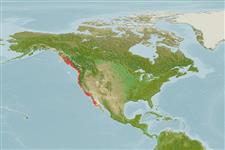Environment: milieu / climate zone / depth range / distribution range
Ecologie
marien demersaal; diepte 0 - 200 m (Ref. 2850). Subtropical; 58°N - 26°N, 137°W - 112°W
Eastern Pacific: Sitka, southeastern Alaska to Punta Abrejos, central Baja California, Mexico.
Grootte / Gewicht / Leeftijd
Maturity: Lm ? range ? - ? cm
Max length : 99.0 cm TL mannelijk / geslacht onbekend; (Ref. 2850); max. gepubliceerd gewicht: 14.0 kg (Ref. 27436); max. gerapporteerde leeftijd: 13 Jaren (Ref. 56049)
Korte beschrijving
Determinatiesleutels | Morfologie | Morfometrie
Dorsale stekels (totaal) : 8 - 12; Dorsale zachte stralen (totaal) : 15 - 18; Anale stekels: 0; Anale zachte stralen: 11 - 13; Wervels: 35. Caudal fin barely rounded.
Inhabits rocky, sandy and muddy bottoms as well as kelp beds (Ref. 4925). Adults and juveniles feed on crustaceans, fishes and mollusks (Ref. 6885). Commonly captured by sport fishers (from shore, boats or piers) and by scuba divers (Ref. 2850). Flesh is good eating but eggs are poisonous and will make humans violently ill (Ref. 13513).
Eschmeyer, W.N., E.S. Herald and H. Hammann, 1983. A field guide to Pacific coast fishes of North America. Boston (MA, USA): Houghton Mifflin Company. xii+336 p. (Ref. 2850)
Status op de Rode Lijst van het IUCN (Ref. 130435: Version 2024-1)
Gebruik door de mens
Visserij: commercieel; sportvis: ja; Aquarium: Publieke aquaria
Tools
Speciale rapporten
Download XML
Internetbronnen
Estimates based on models
Preferred temperature (Ref.
123201): 7.5 - 11.6, mean 8.9 °C (based on 40 cells).
Fylogenetische diversiteitsindex (Ref.
82804): PD
50 = 1.0000 [Uniqueness, from 0.5 = low to 2.0 = high].
Bayesian length-weight: a=0.00389 (0.00180 - 0.00842), b=3.12 (2.94 - 3.30), in cm total length, based on all LWR estimates for this body shape (Ref.
93245).
Trofisch niveau (Ref.
69278): 3.6 ±0.47 se; based on food items.
Generation time: 3.2 ( na - na) years. Estimated as median ln(3)/K based on 1
growth studies.
Weerstandsvermogen (Ref.
120179): Gemiddeld, minimale populatieverdubbelingstijd 1,4-4,4 jaar (tm=3; tmax=13; K=0.3, Fec=40,000-90,000).
Prior r = 0.33, 95% CL = 0.22 - 0.50, Based on 4 full stock assessments.
Fishing Vulnerability (Ref.
59153): Moderate vulnerability (37 of 100).
Climate Vulnerability (Ref.
125649): Moderate vulnerability (44 of 100).
Nutrients (Ref.
124155): Calcium = 75.8 [30.9, 167.0] mg/100g; Iron = 0.974 [0.431, 2.041] mg/100g; Protein = 18.4 [16.2, 20.5] %; Omega3 = 0.314 [0.140, 0.892] g/100g; Selenium = 48.9 [24.8, 117.3] μg/100g; VitaminA = 6.13 [2.10, 17.38] μg/100g; Zinc = 0.592 [0.387, 0.936] mg/100g (wet weight);
